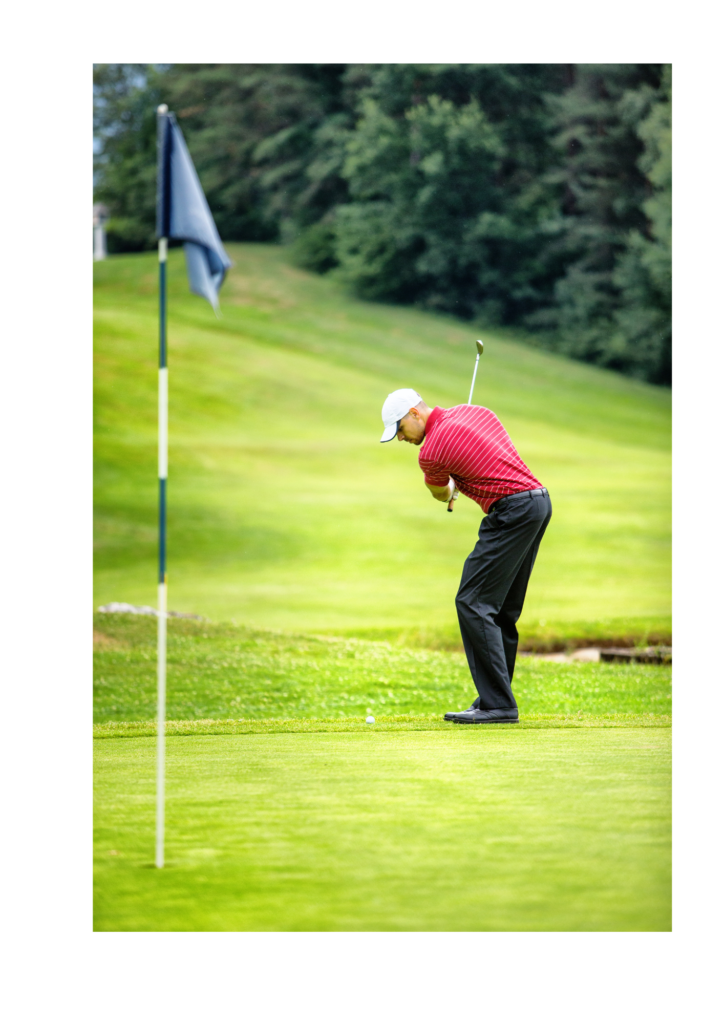
The Arthritis Foundation www.arthritis.org suggests that Golf offers those suffering with Arthritis many physical benefits such as improved strength, balance and co-ordination and better range of motion.
Coupled with this are the psychological benefits that are gained by being active out in the open air with friends. These psychological boosts can contribute to helping with the pain and anxiety that Arthritis can cause
I see many patients with Arthritis on a daily basis as a Physiotherapist and a lot of golfers too. The bottom line is that physical activity (including golf) can help your symptoms. Arthritis shouldn’t be seen as the end of your golf career! In some cases some modifications should be made in order to prepare and to play the game so read to the end to find out what these are.
What is Osteoarthritis?
It is beyond the scope of this article to discuss all the varying types of arthritis – and there are many – it is not one single condition. So I will concentrate on the most prevalent – Osteoarthritis. It is estimated that some 8.75 million people in the UK have the condition (www.versusarthritis.org).
Osteoarthritis (OA) starts with small areas of disruption to the cartilage that lines and protects the bones of a joint. (Think knee, hip, ankle, spine etc) The body will then react to this process by employing its front line heal and repair processes. Sometimes it does not manage the process efficiently. This can result in increased joint fluid, laying down of tiny bits of bone (osteophytes) as the body attempts to heal the cartilage and can eventually can lead to some malformation of the joint itself.
All these joint changes can lead to pain and stiffness in the affected joint(s). It is characterised by morning pain and restricted movement which then eases a little as the day goes on. As the joint is used, joint fluid bathes the joint and the movement improves. The core temperature of your body has also risen which helps with joint function too.
The Challenges of Golf with Arthritis
I’m a keen golfer and some of the members at my club (Stoke by Nayland Golf Club https://www.stokebynayland.com/) that I play golf with have now become my patients when they have started to suffer with the signs and symptoms of arthritis. – they typically experience pain in the hips, knees, back or wrists and hands. The good news is they’ve managed to continue to play the sport that they love despite suffering symptoms.
They reported symptoms such as:
- Struggling to walk round 18 holes
- Pain and stiffness when bending to pick the ball up
- Unable to fully complete their swing because of painful hips and knees
- Unable to fully rotate to the top of their backswing
- Being unable to grip the club comfortably
- Being able to set the wrist appropriately due to pain
Sometimes the symptoms of arthritis can be transient. Or just better on some days than others and this can be sometimes difficult to understand for the golfer.
What you can do to make things easier
Get stronger
I always advise my patients to improve their physical strength and muscular endurance.
This doesn’t have to be too involved either – just some basic strength exercises when performed regularly can help to improve the stability of the joints. These can all be performed at home with some basic equipment and do not require a gym.
These exercises should be completed 3-4 times per week. I have picked 5 of my favourites that you could start with. Look to complete 2-3 sets of 10-15 repetitions of the following:
Squat
Bridge
Heel Raise
Bent Over Row
Shoulder Press
Improve your flexibility
Although in order of preference I’d like my patients to work on their strength first, improving flexibility and mobility will help to mobilise stiff joints and make them more reliable during a round of golf.
Flexibility work can be completed daily if you have the time, but if you don’t 3-4 times per week will see you benefit massively.
Exercises such as:
Cat/Camel
Lumbar Rotations
Knee Flexion/Extension
Upper Back Rotations
Shoulder Shrugs
Wrist Circles
Keep to a healthy weight
This is important. Remember Arthritis is essentially a degradation of the shock absorbing cartilage in your joints. If you are carrying a few extra pounds this can unduly load your back, hips, knees, ankles and feet. Although you should be at your optimum body mass index going forwards – and you can check yours here: https://www.nhs.uk/live-well/healthy-weight/bmi-calculator/ the research has suggested that even if you lose a few pounds but remain overweight in general that this can have a positive impact on your symptoms.
Modify your golf set up
If you generally carry your clubs you could try using a trolley and if your symptoms are severe you should consider a buggy rather than trying to battle around 18 holes walking.
You can also look at your club set up. If you are losing strength and mobility you could consider opting for a regular, senior or graphite flex club. This will reduce the demand on your body when you are swinging the club. If you are having trouble gripping the club you could consider bigger grips on your clubs.
Sometimes it is necessary to modify your swing altogether. If you’ve lost hip mobility for example. (Check out this article I’ve written on the importance of hip mobility in the golf swing: https://golfphysioguru.com/hip-mobility-in-the-golf-swing-a-physios-review/
You may find that your back swing and follow through need to be curtailed or your wrist position modified. Speak to your local Pro, they are best placed to advise you on this.
Seek professional help
You can follow the general tips listed above and they will help you but there is nothing like getting a tailored plan from your local physiotherapist to help you manage your Arthritis. If you are looking for a golf specific plan feel free to book here to see me in person or for a virtual session https://www.mtphysioclinic.co.uk/
In some cases when the pain or dysfunction of arthritis makes general day to day life difficult, joint surgery may be considered but the good news is this will enable you to return to playing golf again after an appropriate period of rehabilitation.
Conclusion
Golf is good for arthritis. It can help with many physical and psychological symptoms brought on by the condition. If the symptoms progress and worsen over time, there are many adaptations that can be made and strategies employed to keep you out on the course.
Happy golfing!
